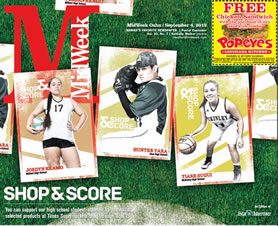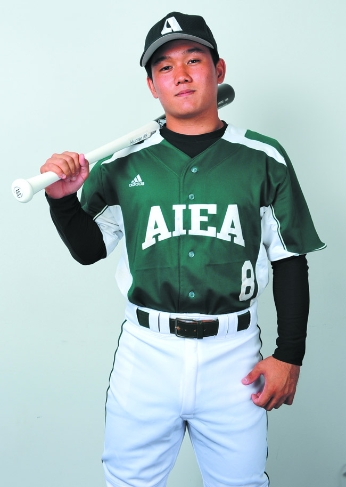Shop & Score
Shop at Times Supermarket now through Oct. 15 and your purchase of selected sponsor products will earn points toward athletic equipment for the school of your choice
In the 21st century, high school’s main objective is to graduate all students who are not only healthy, but properly prepared for a modern world, where priorities for workers differ greatly from their parents’ generation.
The paradox schools face, according to everyone from the Centers for Disease Control (CDC) to the Center for Public Education, is that one of the best tools to accomplish these goals is high school athletics, and yet they are the ones seeing their budgets cut most severely.
“We had the budget slashed 50 percent a few years ago,” says Stacie Nii, athletic director at Waipahu High. “We are down to one coach per sport and we expect so much from them, but we have really great coaches and lots of volunteers.”
The first of these objectives, healthy students, is the most obvious benefit of high school athletics – and the most pressing, to which the kids’ burgeoning waistlines attest.
“All our athletes are conditioned well to avoid injuries, and it really helps cut down on obesity. It allows them to stay healthy,” says Mililani High AD Glenn Nitta, who has run the school’s athletic department for the past 13 years.
According to a July report from the CDC, obesity in adolescents has tripled since 1983, making 18 percent of our high-schoolers obese and 33 percent of them overweight. This not only severely lowers their self-esteem, according to the CDC, but also raises their rates for diabetes, heart disease and cancer.
The American Academy of Child & Adolescent Psychiatry estimates in a 2011 report that unhealthy weight gain and lack of exercise are responsible for more than 300,000 deaths per year, and their cost to society in the U.S. rings in at $100 billion a year.
Recently, former Surgeon General Richard Carmona characterized the epidemic: “Because of the increasing rates of obesity, unhealthy eating habits and physical inactivity, we may see the first generation that will be less healthy and have a shorter life expectancy than their parents.”
The urgency of these words is the driving force behind the 13th annual Shop and Score at Times Supermarket, where shoppers can purchase thousands of items from main sponsor Kraft Foods and others like Nabisco, ConAgra, Pepsi and Kellogg’s and earn points for their high school’s athletics program. Up for grabs is $250,000 worth of adidas athletic equipment and uniforms, as well as $25,000 in scholarships for students from American Savings Bank.
“Everybody gets this. It is about the kids, whether you were a bad athlete like me in school, it is the importance of being on a team and the fitness,” says Bob Stout, president of Times Supermarket and a self-proclaimed terrible high school tight end in Daly City, Calif. “Athletics is so much a part of keeping them from being a couch potato. I know, when I was in school, the coaches were always on you to eat right, to sleep right – this helps mitigate the problems caused by obesity.”
The importance of athletics goes beyond the physical good it does for young and old bodies alike. For Nitta, it may be the best carrot he has to help keep kids in school and excelling.
“It is a privilege to play high school sports. It keeps the students off the streets and focused in the classroom,” says Nitta, who has been at Mililani High since it opened 41 years ago.
“We save a lot of kids. If they weren’t participating in sports, they would not be doing well in school. It gives them pride to put on that uniform and represent their high school. It keeps them focused.”
Those uniforms are where a lot of the cost of athletics comes in and why Shop and Score has become so valuable to the schools.
“That is the most rewarding part of the program, hearing back from the ADs about the effects it has had,” says Gerald Shintaku, business manager of Kraft Foods Hawaii. “Much like any of us driving around in a new car, wearing a new school uniform makes you have extra pride – not to mention keeping them physically fit, helping their character and making for nice, well-rounded students for the future.”
Nitta echoes Shintaku’s thoughts on the matter, and as an AD managing ever-shrinking budgets, appreciates every dollar they can raise, even going so far as deploying the cheerleading squads on a Saturday to encourage people to shop at Times and earn the school points.
“The last couple of years it helped us so much,” says Nitta, who saw his school rise from ninth to second in the Shop and Score point totals last year. “Just football uniforms alone cost more than $200 a set, and we need home and away jerseys. All the money that we saved on those allowed us to get uniforms for all the other programs, like volleyball, track and softball. It helps tremendously.”
While Nitta’s campaign has helped raise the school in the ranks, he also credits the opening of a Times store in the community for helping in the ascension. But the best part of the program is its flexibility: Contributors don’t have to live in the area they want to support.
“Wherever they are, they can designate any school they like and support the school they want and help their nieces and nephews. It’s a nice way to give when you just buy the things you usually buy,” says Shintaku, a graduate of Pearl City High.
Nii appreciates that aspect of the program, because she has seen support from all over the island.
“All the support they give us is amazing. The community really buys into it and they give us the points,” says Nii, who played basketball and softball at Aiea High. “A lot of people outside the area give us their points, too. It is a way they can give back to the community from the outside.”
The final area in which high school athletics enables our students is in preparing them for the modern work-place. Gone are the needs for factory workers and IT support, this all can be done overseas for pennies on the dollar. As writer Daniel Pink outlines in his new book, A Whole New Mind, the thinking and training of young people now needs to be focused on right-brain thinking, creativity and empathy, not the basic number crunching and rote memorization of the past.
This holds up in a study from education expert Craig Jerald in his 2009 paper, “Defining a 21st Century Education.” According to Jerald, the top three skills sought out by employers are critical thinking/problem solving, team work/collaboration and creativity. He found that 70 percent of high school graduates were deficient in these exact three areas, and he found that one of the best training grounds for these skills can be found right on the gridiron, court and diamond.
“It keeps the kids busy; their minds are working,” says Nii, who has been AD since 2005. “They are not out in the community making trouble. They’re getting the physical fitness, coaches monitoring their grades, and it allows their college dreams to be a little bit bigger.”
Preparing the children for the workplace is the most important job schools have, and yet the resource that seems best-suited for preparing them for the next step slowing is being whittled away by tightening belts as kids’ bellies flop over their own belts.
There was an old bumper sticker that said, “It will be a great day when our schools get all the money they need and the Air Force has to hold a bake sale to buy a bomber.” An admirable sentiment, but until then, Hawaii schools will have to make do with Shop and Score.
“We just hope we can keep doing it,” says Stout. “With all the cutbacks at the schools, it is sad that this program has become so important. I am glad our vendor partners and ourselves can do it, ’cause it is helping the kids, and they are our future.”







